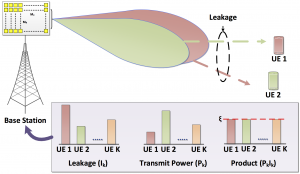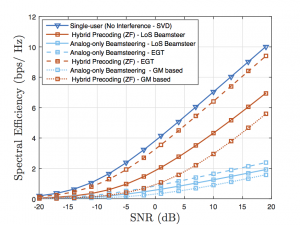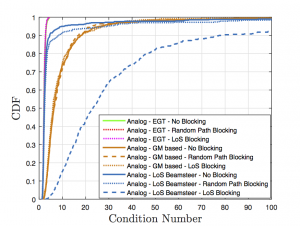One second track of contributions was to design new signal processing algorithm for future practical implementation of massive MIMO systems at mmWaves. On the one hand, we have put efforts on resource allocation and user grouping strategies, again taking into account the specificities of mmWave propagation. On one other hand, we have led a specific analysis on sparse massive MIMO channel decomposition in the perspective of channel estimation mechanisms.
Angular based beamforming and power allocation
Millimeter-Wave (mmWave) systems offer extremely large Band-Width (BW) and highly Line-of-Sight (LOS) dominant channels. Many beamforming and power allocation techniques have recently emerged to leverage such channel characteristics in order to enhance the sum capacity and the coverage for multi-user transmissions. However, most of the existing algorithms are practically limited due to full channel knowledge and high complexity requirements. From this matter of fact, we have introduced a low complexity, angular based beamforming and power allocation framework, that requires the knowledge of the main contributive Directions of Arrival/Departure (DoAs/DoDs) of the propagation channel only. Exploiting the fact that propagation conditions are highly driven by the geometrical structure of the channel in mmWave scenarios, our method relies on the estimation of the leakage caused by each User Equipment (UE) on all the other UEs (see Fig. 1a), approximated from the DoAs contributions. This leads to a low complexity-low overhead scheme favorable to LOS dominated environments as concerned in mmWave massive MIMO deployments. We proved with the simulation results that this approach, in addition to be practically plausible, can enhance the network Spectral Efficiency (SE) alongside with maintaining acceptable data rates for the cell edge UEs (Fig. 1b).
Efficient Hybrid Beamforming facing blockage effects
In addition to the hardware complexity limiting the implementation of fully digital beamforming system in mmWaves, another challenge to consider is the frequent propagation ray blockage due to the small wavelength. A lot of research has thus been dedicated to hybrid beamforming solutions to adapt with hardware limitations, but also trying to solve the ray blockage problem. To that same purpose, we have introduced a novel hybrid beamfoming framework that captures the diversity of the multipath sparse channel in the analog domain using the Equal Gain Transmission (EGT) spatial precoding scheme. We have highlighted how such beamformer can enhance both the Spectral Efficiency (SE) and the robustness of the communication system. But also, we have unleashed the potentials of the Digital Signal Processing (DSP) layer to suppress the Multi-User (MU) interference using the Zero Forcing (ZF) approach. To work appropriately on this issue, we have introduced a generic and realistic channel blockage model. We have finally concluded that our beamforming strategy based on EGT achieves higher performance in terms of SE and robustness to blockage compared to the existing techniques in the literature, namely the conventional LoS beamsteering precoding and that one based on geometric means of the channel eigenvalues. Some performance results in terms of are given Fig 2b.
Degrees of Freedom of Ray-Based Models in mm-Wave Wideband MIMO-OFDM
In this part of the work, we have analyzed the number of degrees of freedom needed to accurately capture and model wideband MIMO-OFDM channels in the perspective of channel estimation. Indeed, Massvie MIMO systems require particular signal processing techniques to operate, such as efficient channel estimation, Channel State Information acquisition, feedback (in FDD) and precoding. Although classical single-antenna techniques can efficiently be mapped to each tx/rx link in small-scale MIMO, large-scale MIMO setups requires advanced techniques that leverage the sparsity of the channel in the angular domain to limit the processing overhead. To that purpose two modeling approaches have been considered for comparison, either examining each coefficient of the conventional input-output MIMO channel matrix or investigating the components constituting the physical ray-based propagation between the antenna arrays. As our analysis accounts for wideband channels, a time domain decomposition of the MIMO channels into tapped delay lines is performed in each case. An example of the accuracy of channel modeling in terms of MSE is given Fig 4a showing that the ray-based representation is much more economic for large antenna arrays. The efficiency of each approach in terms of number of taps has been evaluated to determine the most appropriate representation between either the conventionnal antenna-based one or the propagation-based one. From our investigations, we can predict which representation is the most efficient in terms of number of taps as examplified Fig. 4b. The proposed analysis has been performed analytically using the Saleh-Valenzuela model which is recognized for its consistency for wideband as well as spatial modeling.







